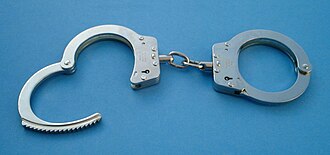Physical restraint
Physical Restraint[edit]

Physical restraint refers to the use of various devices or techniques to limit the movement of an individual's body. It is commonly used in medical, psychiatric, and correctional settings to prevent harm to the individual or others.
Types of Physical Restraints[edit]

Mechanical Restraints[edit]
Mechanical restraints involve the use of devices to restrict movement. Common examples include:

These devices are often used in law enforcement and correctional facilities to secure individuals who may pose a threat to themselves or others.
Physical Holds[edit]
Physical holds involve the use of a person's body to restrict another person's movement. This can include techniques such as:
- Arm holds
- Body holds
These methods are often used in psychiatric settings to manage patients who are experiencing severe agitation or aggression.
Uses of Physical Restraint[edit]

Physical restraint is used in various settings for different purposes:
- Medical Settings: To prevent patients from removing life-saving equipment or harming themselves.
- Psychiatric Settings: To manage patients who are a danger to themselves or others.
- Correctional Facilities: To control inmates who are violent or attempting to escape.
Ethical and Legal Considerations[edit]
The use of physical restraint is subject to ethical and legal scrutiny. It is important to ensure that restraints are used only when necessary and in the least restrictive manner possible. Guidelines and regulations vary by country and institution.
Alternatives to Physical Restraint[edit]

Alternatives to physical restraint include:
- De-escalation techniques
- Behavioral interventions
- Environmental modifications
These alternatives aim to reduce the need for physical restraint by addressing the underlying causes of agitation or aggression.
Controversies and Challenges[edit]

The use of physical restraint is controversial due to potential risks, including physical injury and psychological trauma. There is ongoing debate about the balance between safety and autonomy.
Related Pages[edit]

Conclusion[edit]
Physical restraint is a complex and multifaceted issue that requires careful consideration of ethical, legal, and practical factors. It is essential to prioritize the safety and dignity of individuals while minimizing the use of restraints.

Ad. Transform your life with W8MD's Budget GLP-1 injections from $75


W8MD offers a medical weight loss program to lose weight in Philadelphia. Our physician-supervised medical weight loss provides:
- Weight loss injections in NYC (generic and brand names):
- Zepbound / Mounjaro, Wegovy / Ozempic, Saxenda
- Most insurances accepted or discounted self-pay rates. We will obtain insurance prior authorizations if needed.
- Generic GLP1 weight loss injections from $75 for the starting dose.
- Also offer prescription weight loss medications including Phentermine, Qsymia, Diethylpropion, Contrave etc.
NYC weight loss doctor appointmentsNYC weight loss doctor appointments
Start your NYC weight loss journey today at our NYC medical weight loss and Philadelphia medical weight loss clinics.
- Call 718-946-5500 to lose weight in NYC or for medical weight loss in Philadelphia 215-676-2334.
- Tags:NYC medical weight loss, Philadelphia lose weight Zepbound NYC, Budget GLP1 weight loss injections, Wegovy Philadelphia, Wegovy NYC, Philadelphia medical weight loss, Brookly weight loss and Wegovy NYC
|
WikiMD's Wellness Encyclopedia |
| Let Food Be Thy Medicine Medicine Thy Food - Hippocrates |
Medical Disclaimer: WikiMD is not a substitute for professional medical advice. The information on WikiMD is provided as an information resource only, may be incorrect, outdated or misleading, and is not to be used or relied on for any diagnostic or treatment purposes. Please consult your health care provider before making any healthcare decisions or for guidance about a specific medical condition. WikiMD expressly disclaims responsibility, and shall have no liability, for any damages, loss, injury, or liability whatsoever suffered as a result of your reliance on the information contained in this site. By visiting this site you agree to the foregoing terms and conditions, which may from time to time be changed or supplemented by WikiMD. If you do not agree to the foregoing terms and conditions, you should not enter or use this site. See full disclaimer.
Credits:Most images are courtesy of Wikimedia commons, and templates, categories Wikipedia, licensed under CC BY SA or similar.
Translate this page: - East Asian
中文,
日本,
한국어,
South Asian
हिन्दी,
தமிழ்,
తెలుగు,
Urdu,
ಕನ್ನಡ,
Southeast Asian
Indonesian,
Vietnamese,
Thai,
မြန်မာဘာသာ,
বাংলা
European
español,
Deutsch,
français,
Greek,
português do Brasil,
polski,
română,
русский,
Nederlands,
norsk,
svenska,
suomi,
Italian
Middle Eastern & African
عربى,
Turkish,
Persian,
Hebrew,
Afrikaans,
isiZulu,
Kiswahili,
Other
Bulgarian,
Hungarian,
Czech,
Swedish,
മലയാളം,
मराठी,
ਪੰਜਾਬੀ,
ગુજરાતી,
Portuguese,
Ukrainian